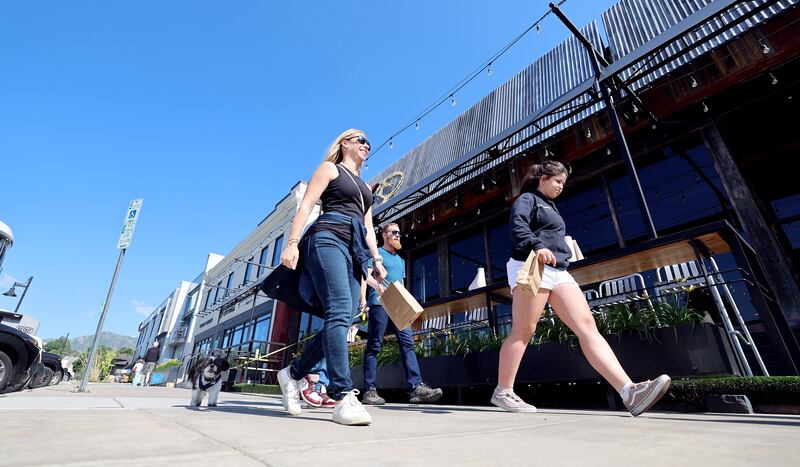Utah's capital city garnered plenty of national attention this year because of data that consistently found that it had recovered from the COVID-19 pandemic much stronger than many other cities in the U.S., but the researchers behind those findings no longer say that's the case.
The University of Toronto School of Cities, which has tracked post-pandemic recovery for a few years now, updated its data last month showing that Salt Lake City's downtown activity this spring was actually just 82% of pre-pandemic levels earlier this year, not 139% as it had originally reported.
This dropped Salt Lake City from having the top recovery to about 23rd out of 66 North American cities it is tracking, or 17th among U.S. cities.
So what happened, and does it really make a difference?
The drop is tied to a few changes to the university's methodology. Researchers are still using cellphone data to track unique visitations within city limits now versus similar time periods before the COVID-19 pandemic; however, it's now using the data company Spectus instead of a mix of two data companies.
The biggest change appears to be that it also altered the definition of downtown to "reflect the central location with the highest concentration of employment."
University of Toronto officials did not respond to KSL.com's request for comment about how these alterations affected Salt Lake City's calculations. However, Karen Chapple, director of the School of Cities and professor of geography and planning at the University of Toronto, recently told Axios that the old data boundaries spewed out into areas south, east and west of downtown, including parts of the city's Ballpark, Central City and Central Ninth neighborhoods, as well as its Granary District.

Downtown leaders aren't particularly surprised by the drop-off in the new data.
"That 82% is more consistent with the measurements we have been doing," said Dee Brewer, executive director of the Salt Lake City Downtown Alliance.
Brewer told KSL.com on Tuesday that he wasn't alerted about the changes, but he noticed the changes a few weeks ago. He said that he was actually surprised to see Salt Lake City's activity reach 139% of pre-pandemic levels when the data was released earlier this year.
While the Downtown Alliance couldn't re-create the figure, Brewer explains that the city accepted the measure because there were some "very unusual spikes" in visitation data from various conventions and sports competitions happening at the time that they acknowledged their data collection methods could have missed.
It's worth noting that three other U.S. cities were listed as being above pre-pandemic levels this spring using the old methodology. Under the new methodology, only Las Vegas — originally listed at 88% of pre-pandemic levels — had any activity growth since the pandemic among all 66 cities. It experienced a modest 3% gain from pre-pandemic activity.
Many other cities either went up or down under the refined data.
Where downtown Salt Lake has recovered
There is a component of both the old and new University of Toronto data that matches the Downtown Alliance's own data since the pandemic began. What's bringing people downtown is different, which is a big reason why activity numbers are still so different between 2019 and 2023.
In Salt Lake City's case, office worker occupancy dominated downtown activation before the pandemic. That hasn't rebounded so far, largely because businesses aren't returning to the city's Class B office spaces.
Its social economy, on the other hand, is faring quite well. The number of outside visitors coming into downtown is actually up 14% from 2019, according to Downtown Alliance data updated this month. Brewer adds that the downtown population is already up about 15%-20% over the past year.
The problem is that the growth in population and in the social economy — people heading to bars, restaurants or downtown events — hasn't accounted for the drop-off in office worker occupancy just yet.
"We're seeing the worker population shrinking — it shrunk a lot over that period of time, but we're seeing a lot more visitors in downtown now," he said. "And, of course, our residential population is growing, as well."
That's the case for many other North American cities.
With the addition of new downtown residential high-rises since 2019, and several more under construction or in the pipeline, Salt Lake City's downtown population is still expected to grow by another 80% to 100% in the coming years. That, in turn, is expected to boost downtown activity.
Brewer adds that he expects more Class B office spaces will be "reimagined" into other uses. At least one of these is set to be converted into new residential units.
In short, downtown leaders do expect to surpass pre-pandemic levels, it's just taking a bit longer than what was originally reported by the University of Toronto under its old methodology.
"We will have more people living downtown ... and that will create new opportunities for businesses and retailers," Brewer said. "That's a positive thing.”


